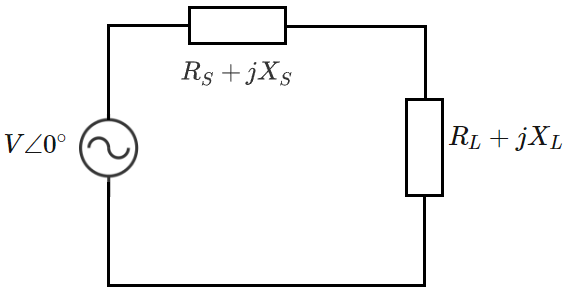Conjugate Impedance Matching

Consider the AC system shown above. There is a source with impedance and a load with impedance . The resistive components must be positive (per standard physics), and the reactive components can be either positive or negative (corresponding to inductive / capacitive components respectively). The source voltage angle is shown as zero degrees, but this angle is actually irrelevant.
Suppose we want to maximize the active power (Watts) dissipated by the load. What should the load impedance parameters be?
Derive an expression for the magnitude of the load current:
Load power:
Since is a constant, we therefore want to maximize the following quantity:
Assume that this function is both continuous and continuously differentiable in both variables . Take partial derivatives with respect to both variables and set them equal to zero. This is a multi-variate version of the standard calculus-based optimization strategy. I will also neglect to perform the equivalent of a "second derivative test" here. The mathematically inclined reader is free to try these as side problems. I don't want to get bogged down in mathematical details.
Since we are maximizing the load active power, we must obviously neglect the case in which .
The resulting expression from the partial derivative thus reduces to:
Since the resistive terms cannot be negative, and cannot be zero, the following results:
We see, therefore, that in order to maximize the active power dissipated by the load, the load resistance must match the source resistance, and the load reactance must be the negative of the source reactance. In more technical language, the load impedance must be the complex conjugate of the source impedance.
Easy Math Editor
This discussion board is a place to discuss our Daily Challenges and the math and science related to those challenges. Explanations are more than just a solution — they should explain the steps and thinking strategies that you used to obtain the solution. Comments should further the discussion of math and science.
When posting on Brilliant:
*italics*or_italics_**bold**or__bold__paragraph 1
paragraph 2
[example link](https://brilliant.org)> This is a quote# I indented these lines # 4 spaces, and now they show # up as a code block. print "hello world"\(...\)or\[...\]to ensure proper formatting.2 \times 32^{34}a_{i-1}\frac{2}{3}\sqrt{2}\sum_{i=1}^3\sin \theta\boxed{123}Comments
There are no comments in this discussion.